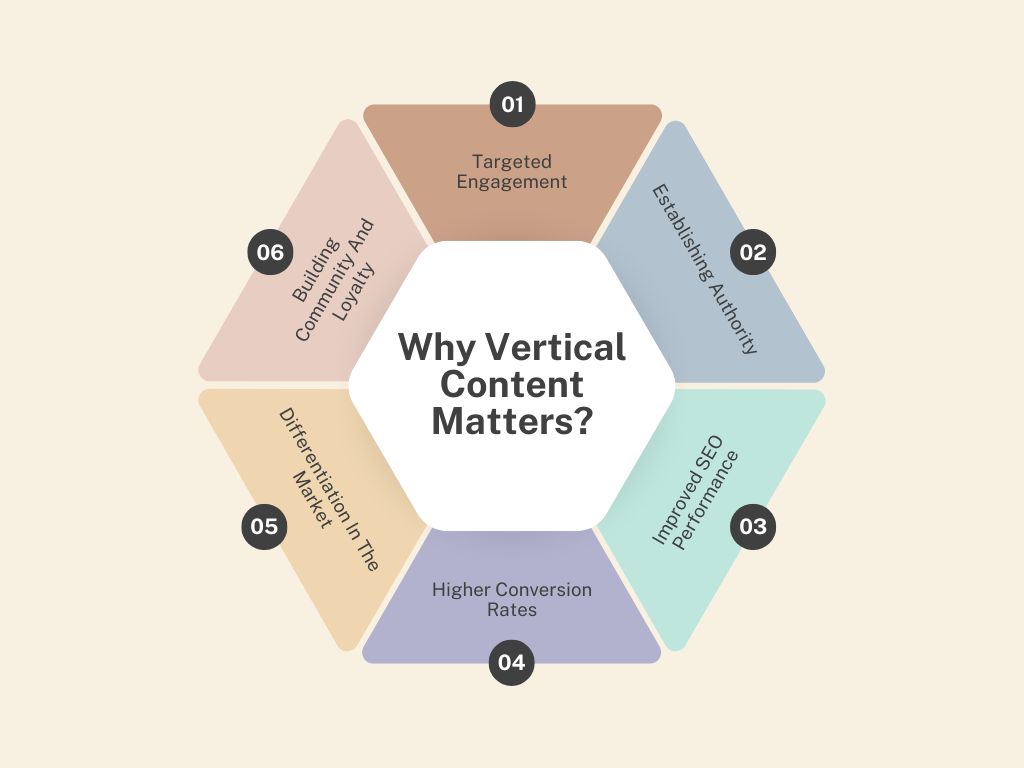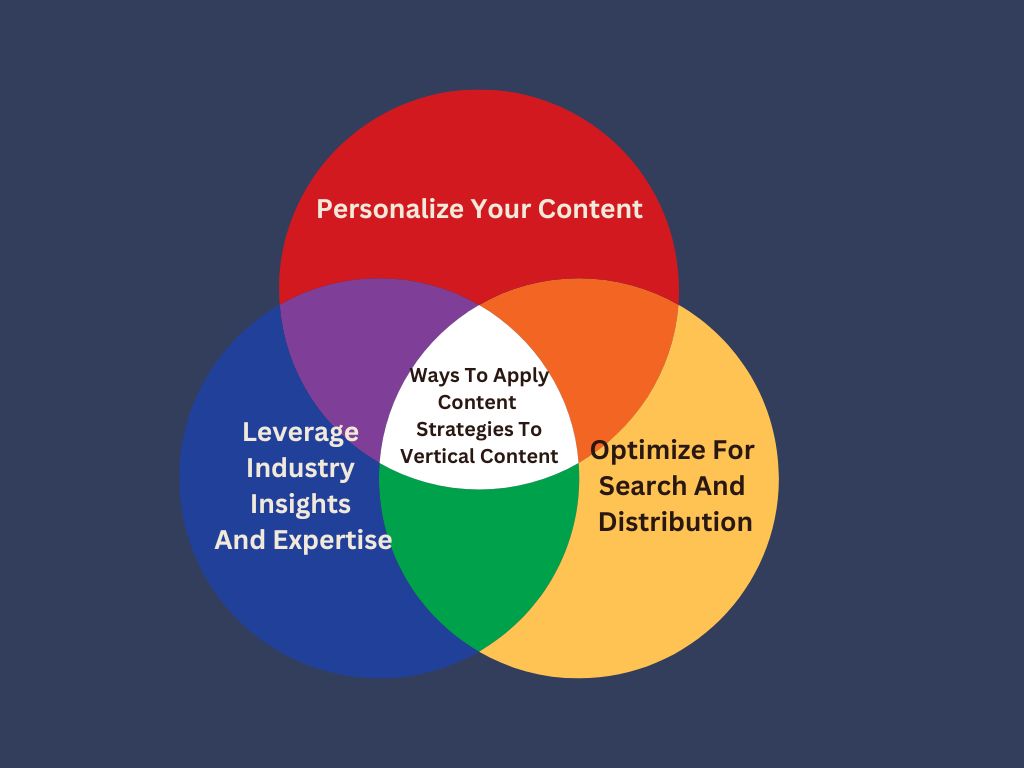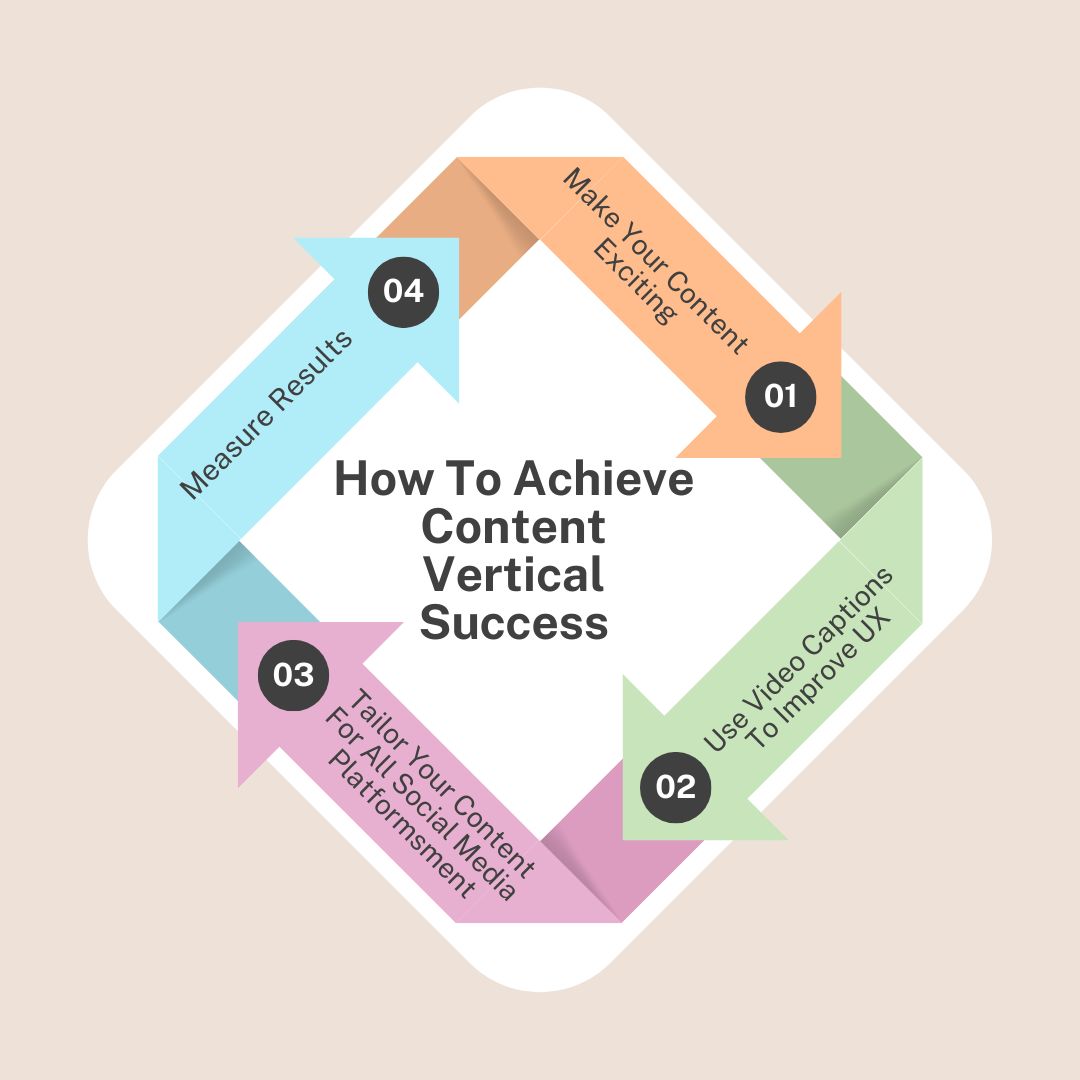Everyone on the internet is producing some kind of content.
There are more than 600 million blogs on the internet. While creating content, you’re not just competing with these, but with the influencers, pet influencers, and every other person who has a considerable following. In this plethora of content available online, people who are looking for content in specific niches get lost. The same is what happens with the people publishing niche content.
Having a content marketing strategy is not enough anymore. You need to discover topics that connect your customers to you and speak directly to them.
This is where vertical content comes in. Let’s have a look at what vertical content is, its comparison to horizontal content, why it matters, examples, and how you can achieve it.
What Is Vertical Content?
Vertical content is a type of content that is tailored specifically to an industry or specific niches. Vertical content dives deep into the needs, interests, and pain points of a very targeted group of audience. This type of content is often used to establish credibility and authority in a specific sector.
Vertical content is industry-specific detailed and in-depth blogs that establish your expertise in a particular industry. A vertical content plan is aimed at a niche audience with specific needs and interests and hence drives purposeful engagement.
By addressing the very specific needs of the audience, the content you produce will prove to resonate more, drive better rates of engagement, and effectively guide potential customers through the sales funnel leading to better conversions.
Horizontal v/s Vertical Content
Horizontal and vertical content are two unique approaches to content marketing campaigns, where one is designed to focus on a wider set of audiences and masses, and the other is to focus on a very specific and niche audience, respectively.
Horizontal Content
Horizontal content is a broad and general type of content that caters to a wider set of audience across industries and sectors. This content focuses on topics that appeal to the masses and not a specific target audience.
How-to guides, listicles, and general news articles majorly focus on the horizontal type of content and cover very general topics that are scalable and SEO friendly. Horizontal content targets an expansive audience with varying interests with the primary aim of increasing brand awareness.
Vertical Content
Vertical content is a type of content that focuses on a very niche and specific type of audience that is relevant to a particular sector or industry. This content majorly aims to provide in-depth and detailed information to a specialized group of audience.
Industry blogs, white papers, podcasts, and seminars majorly focus on vertical content with niched-down topics that create credibility and authority in the industry. Vertical content targets specialized audiences with a specific interest and aims to build strong relationships with the audience with the usage of low-competition keywords.
Comparison Table
| Aspect | Horizontal Content | Vertical Content |
| Audience | Broad and diverse; content for masses | Niche and specific; content for specific groups |
| Topics | General and widely applicable | Niche and industry-specific |
| Objectives | Brand awareness and broad reach | Engagement and authority within a niche |
| SEO Strategy | High-volume keywords | Low-competition keywords |
| Engagement | Lower engagement rates | Higher engagement due to targeted content |
| Examples | How-to guides, listicles, general news | Industry blogs, white papers, webinars |
Why Vertical Content Matters?
Vertical content plays a significant role in content marketing campaigns by producing content that is specific to industry and niche audiences. This type of content is specifically designed to address the special interests, needs, and pain points of a particular set of audiences, which makes it an essential content marketing strategy. This helps in establishing the brand’s authority and credibility among the audience.
Following are some of the main reasons why vertical content matters.

Targeted Engagement
Vertical content allows you to connect with your audience on a very personal level that resonates with their pain points and interests, by focusing on content that aligns with the demands and needs of your audience, and better your engagement rates.
This targeted focus on a particular niche ensures that the quality content you create speaks directly to an audience and hence increases the chances of engagement and interaction. With this, businesses can develop a loyal community and also increase customer retention by keeping their customers engaged with targeted content.
Establishing Authority
Creating high-quality vertical content that resonates with your target group audience and speaks directly to them, establishes you as a thought leader in the industry. By consistently providing valuable content, insights, and expert opinions, brands can showcase their expertise.
nThis enhances a brand’s reputation, increases its authority and credibility among the audience and builds trust with them which makes it more likely for them to choose your brand. Being recognized as a thought leader in the industry opens several opportunities for collaborative partnerships in the industry.
Improved SEO Performance
Vertical content targets very specific and low-competition keywords that are relevant only to a specific niche, which helps in enhancing SEO efforts and ranking better in SERPs. By focusing on long-tail keywords and industry-specific keywords, websites can attract more qualified traffic.
Vertical content will drive organic traffic to your website and also ensure that your audience is genuinely interested in your content, which would lead to higher engagement, better conversion rates, and better overall marketing and SEO performance.
Higher Conversion Rates
Vertical content is tailored specifically to address the pain points and needs of the target audience, it is more effective in guiding potential customers through the sales funnel and converting them into loyal customers.
By providing detailed information and relevant solutions to your audience’s problems, brands can nurture leads and convert them. This type of targeted approach leads to better conversion rates in comparison to generic content as it speaks directly to the pain points of the audience.
Differentiation In The Market
Vertical content helps brands stand out in the market with specialized information that is not widely available on the internet and helps your brand stand out in the cluttered and competitive market. This also highlights their features and differentiators.
By focusing on niche topics and providing information that is scarcely available, brands can highlight their unique value proposition in the market. This differentiator becomes necessary in the cluttered market where people are seeking specific information instead of the generic one available.
Building Community And Loyalty
Vertical content fosters a sense of community among the people who are interested in the specific niche content as they have similar interests and share the same challenges, hence more chances of converting leads.
With vertical content, businesses can create a loyal following and encourage them to interact with each other and the brand. This can lead to a better sense of brand loyalty, word-of-mouth marketing, and long-term relationships with the customers.
3 Ways To Apply Content Strategies To Vertical Content
Applying content strategies to vertical content involves aligning your content marketing approach to meet the needs and interests of your specific audience segment within a particular niche or industry. Following are 3 ways to apply content strategies to vertical content.

Personalize Your Content
Personalization enhances the relevance and engagement of your content making it more effective at addressing the specific needs and demands of your niche audience. By dividing your audience into smaller segments, create more targeted and relevant content.
Draft messages that speak directly to your audience’s pain points and interests, and use tone and examples that resonate with the audience’s experiences and challenges to have better engagement and conversion rates.
Leverage Industry Insights And Expertise
Establishing yourself as a thought leader in the industry with the help of in-depth content and valuable insights from the industry will build trust and credibility among the audience, which will lead to increased engagement, consumer loyalty, and a better conversion rate.
Collaborate with industry experts and influencers to create content, such as interviews and guest posts. Their expertise can add value and credibility to your brand and also boost your engagement. Highlight the benefits and outcomes of your services and provide tangible proof of your expertise to the audience.
Optimize For Search And Distribution
To maximize your content’s visibility and impact, optimize your content for search engines and distribution channels and ensure that it reaches the right audience effectively. Focus on long-tail keywords to increase your rankings and attract more qualified leads to your content.
Adapt your content for the platforms where your audience is the most active and repurpose your content across multiple formats and platforms to enhance its reach and increase the lifespan of your content.
Branded Content Examples Of Vertical Content
Vertical Content is designed especially for niche audiences. This type of content focuses highly on topics that are highly relevant to a particular industry, sector, or demographic. Following are some effective use of vertical content strategies.
Sephora’s Beauty Tutorials
Sephora is a leading brand in the beauty and makeup sphere with its makeup, skincare, hair, fragrance, and more. Sephora creates makeup tutorials and videos with beauty tips that are specially targeted at beauty enthusiasts and people interested in a particular niche.
By adopting YouTube videos, Instagram reels, live streams, and other special events, Sephora makes its tutorials accessible to everyone. By providing educational content and showcasing its products live, Sephora establishes itself as an authority in the beauty industry while engaging its customers and potential audiences effectively.
Spotify’s Wrapped Campaign
Spotify Wrapped is an annual campaign that analyzes and personalizes the user’s listening data throughout the year and summarizes their listening habits to create a customized playlist. This campaign is targeted at Spotify’s users, music enthusiasts, and other interested people.
With the help of social media posts and interactive web experiences, the campaign creates buzz among users all over social media and encourages sharing and hence gains traction and engagement. This also helps in reinforcing Spotify’s presence in the music streaming industry.
Nike’s Athlete Stories
Nike is an athletic footwear brand that produces content for the specific sports niche. The content often focuses on the journeys, successes, and challenges of the athletes. This type of content often resonates with sports enthusiasts and aspiring athletes.
Taking short films, social media, and articles on their website as their medium, the brand engages their audience and potential customers. Aligning the stories of athletes, Nike enhances its brand’s ethos of perseverance and performance.
Airbnb’s Neighbourhood Guide
Airbnb is an online marketplace that connects people who want to rent their property and people who are looking for accommodation. It offers localized neighborhood guides that highlight local attractions and experiences, targeted especially at travelers seeking new adventures.
Blog posts and interactive maps on Airbnb’s website promote authentic travel experiences and enhance its brand’s appeal to adventure-seeking people. Airbnb differentiates itself from traditional accommodation options and makes its authority in the market.
How To Achieve Content Vertical Success
To achieve vertical content success, you need to focus on strategies that enhance engagement, user experience, and platform-specific achievement. But how can you use these tactics? Let’s see.

Make Your Content Exciting
Creating content that is engaging and dynamic is significant to keep your audience engaged and interested in your content throughout. You can craft stories and narratives that resonate with your audience and directly address their pain points.
Usage of eye-catching visuals, infographics, and videos to complement your text can make your content more compelling. Along with texts and visuals, you can use interactive content like quizzes and polls in your content to increase the time spent on your page and encourage sharing.
Use Video Captions To Improve UX
Video content is getting increasingly popular with its accessibility and user experience. Having captions with your videos can make them more inclusive and reach a wider set of audience including the ones with hearing disability. This can expand your reach and also improve the user experience.
Several users watch videos on mute, for which captions can convey your message even without any sound. Moreover, captions can include keywords, for which the search engines crawl and hence rank better in SERPs. This also helps viewers understand the message better, especially if there is complex terminology.
Tailor Your Content For All Social Media Platforms
Every social media platform has its own characteristics and distinct qualities that appeal to a particular type of audience. Tailoring your content according to each social media platform can help you gain a wide set of audience and maximize the effectiveness of your content. Recognize that each social media platform has a different audience and unique content preferences.
Use the unique features of each platform, like Reels in Instagram, LI articles for LinkedIn, and a concise update for X. Maintaining a consistent brand voice and design language across all social media platforms while tailoring your content to suit each platform’s algorithm, its audience, and their interests.
Measure Results
It is significant to measure your results and analyze its performance to check the efficiency and effectiveness of your content. Set clear objectives to effectively measure your results, whether it is increased engagement, higher conversion rates, or maximized reach. You can use tools like Google Analytics to track important metrics such as views, clicks, and conversions.
Analyzing your content’s performance regularly can help you in identifying which content resonates with your audience and make informed decisions based on these metrics. Refine your content strategy with the help of the insights gained, focus on what works well and experiment with new ideas for underperforming areas.
How To Create Content Verticals?
Creating content verticals means developing specialized content streams that target a particular audience segment within your broader audience. This approach would allow you to create content according to the specific needs and preferences of the audience and establish your credibility in the industry. Following are some ways for you to create content verticals.

Research Your Target Audience
Understanding your target audience is the first step towards creating content verticals and tailoring content according to their needs, preferences, and pain points. Collect basic information like name, age, gender, and demographics to get the basic details about them and understand their interests, needs, and preferences to personalize content for them.
Track how your audience interacts with your brand and content, including their purchasing behavior, content consumption, and online engagement too. With the use of surveys, feedback forms, and interviews, you can gain insights into their actual preferences and needs, and hence make data-driven decisions based on them.
Create Target Customer Or Client Profiles
After researching and understanding your audience, create detailed customer personas to guide you through the process of content creation. Develop customer personas that represent the different segments of your audience using varying factors like demographics, challenges, age groups, and preferred platforms to consume content.
Get clear data and define accordingly what are the specific needs and challenges of each persona and tailor your content accordingly to suit each one’s pain points. Determine each persona’s preferred way of consuming content whether it is blog posts, social media, podcasts, or videos, and create your vertical content strategy accordingly.
Reshape Your Content Creation
Now that you understand your target audience and have created personas for them, you should reshape your content creation to align with their needs and preferences. Focus on creating content that speaks directly to them and addresses their pain points. This can include in-depth articles, case studies, or niche articles.
Tailor messages to each created persona’s unique characteristics and speak directly to their pain points. Incorporate a wide range of content formats to cater to audiences with different preferences, such as videos, infographics, and interactive content while maintaining a consistent brand voice to let people make a conscious choice.
Come Up With A Content Strategy
A well-defined content strategy is significant for executing your content verticals effectively. Clearly define the goals and objectives that you want to achieve with the help of your content, whether it is increasing engagement, brand awareness, or simply engaging your audience. Develop a content calendar and schedule publication dates to abide by deadlines.
Identify what channels work the best for your audience, whether it is social media platforms, blogs, case studies, or industry forums. Establish KPIs to evaluate the effectiveness of your campaigns and regularly keep track of your metrics to gain insights on what is working and what is not and make informed decisions on the basis of insights.
Examples Of Vertical Content
Vertical content focuses on creating in-depth and specialized content for a particular niche or industry. Following are some examples of vertical content across various industries.
Healthcare Industry
The Healthcare industry is one of the most targeted and niche industries which does not spark the interest of everyone. Medical research articles such as in-depth analysis, medical studies, and research targets healthcare professionals and students in the field of study.
Technology Sector

The technology sector majorly includes how-to guides, in-depth reviews, and detailed reports on recent tech trends that are targeted towards tech professionals, industry insiders, or enthusiastic tech consumers who analyze every product before using.
Finance And Investment

Finance and investment is a sector that is not understood easily by everybody and not many people have their interest in the sector. Analysis of financial markets, investment opportunities, and economic trends are targeted at investors and financial professionals. Personal finance tips, such as budgeting or investing are aimed at individuals to provide financial literacy.
Travel And Tourism
Content in the travel and tourism industry includes destination guides and travel tips that are consumed either by people in the industry or travel enthusiasts. In-depth guides on travel destinations, tourist attractions, tips for travel planning, and packing are targeted at frequent travelers.
How Is Vertical Content And Social Media Stories Revolutionizing Content Marketing?
Vertical content lets the brands focus on niche audiences by providing them with specific and highly relevant information that aligns with their needs and pain points. While achieving your engagement goals, vertical content also enhances your SEO and discoverability on the SERPs and builds a loyal community that engages with your brand and spreads word-of-mouth.
Social media stories offer a platform for real-time engagement, fostering a sense of immediacy and relevance to engage. The interactive features on the stories like polls, Q&As, and quizzes boost engagement and allow brands to form a connection with the audience with the help of behind-the-scenes and other visually appealing content.
With complementary strategies, vertical content and social media stories can work together to create a comprehensive strategy while also cross-promoting your content. With the insights gained from metrics of both vertical content and social media strategies, you can make informed content strategies to get better results. Moreover, social media stories can act as a feedback loop, allowing brands to quickly adapt and refine their strategies.
Final Words
By focusing on vertical content, brands can create more specialized and niche content that focuses on a particular set of audiences. With vertical content, brands can have a more personalized and impactful approach which strengthens their position in the industry. It addresses the specific needs, preferences, and pain points of a particular group, making it an essential strategy for businesses and to get the best content strategy, contact Rank Scholars today!

Anubhuti is a freelance writer who crafts engaging content. Running on a single cup of coffee, on most days, she prefers books and music over people and loves creating compelling content for you!



